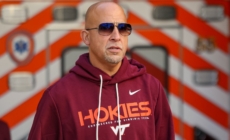-
Dodgers Predicted to Make ‘Villainous’ Signing at Winter Meetings - 23 mins ago
-
Benin Coup Attempt to Oust Talon Has Been Foiled, Interior Minister Says - 28 mins ago
-
Virginia Tech, James Franklin Looking to Make Surprising Coaching Move - 58 mins ago
-
Presidential Power Gets Tested Before Supreme Court After Long Conservative Project to Shrink Agencies - about 1 hour ago
-
Student Loan Delinquencies Surge to Alarming Levels—Credit Score Report - 2 hours ago
-
Not All Targeted Killings Are the Same. Hegseth’s Boat Strikes Are Illegal. - 2 hours ago
-
Congress Rewrites Hemp Definition, Reshaping Cannabis Rules - 2 hours ago
-
Pacific Palisades residents preserve community with block party - 2 hours ago
-
Your Gift Dilemmas, Solved - 3 hours ago
-
Woman’s Gift for Best Friend 25 Years in the Making Has Strangers in Tears - 3 hours ago
L.A. Unified test scores rise above pre-pandemic levels.

After years of struggling to recover from deep pandemic setbacks, Los Angeles Unified students have achieved a “new high watermark,” with math and English scores rising across all tested grades for the second straight year, surpassing results from before the 2020 campus closures, Supt. Alberto Carvalho said.
Two years of incremental gains at every tested grade level is generally considered solid evidence that instruction is moving in the right direction, said Carvalho along with education experts.
“The coolest thing is that the district, despite all that this community went through, has now reached the highest-ever performance at all levels in English language arts and math,” Carvalho said in an interview with The Times. He is to announce the results Tuesday during his annual address to administrators and guests at Disney Concert Hall.
“We didn’t just take it back to pre-pandemic levels. We exceeded pre-pandemic levels of performance,” he said to The Times. “We established a new high watermark.”
Morgan Scott Polikoff, a professor at USC’s Rossier School of Education described the gains as “indeed impressive and seem to have, in most cases, more than erased losses attributable to the pandemic … This is an important development and the district should be proud of it.”
Nonetheless, overall results show that achievement — as measured by test scores — in the nation’s second-largest school system remains a work-in-progress.
“Large proportions of students in the district, especially students from underrepresented racial and ethnic groups, are still performing below state standard,” Polikoff said.
In total, 46.5% of students met or exceeded grade level standards in English Language Arts in tests conducted in April and May. In math, the figure was 36.7%. The overall numbers indicate that nearly two in three students are not meeting the math standards for their grade in the school system of about 400,000 students.
Brights spots in the scores
But scores look better in the details.
In math, for example, scores rose 3.92 percentage points, a strong gain for one year. Last year, the gain was 2.3 percentage points — also a solid gain — bringing L.A. Unified, at the time, to within 2.7 points of the entire state. It’s possible that L.A. Unified overtook the state average this year in math — although statewide data has yet to be released.
This year’s gains appeared to be across the board — reaching students with disabilities, students from low-income families, Latino students and Black students.
As a group, Black students rose at least four percentage points in both English and math. Nonetheless, three in four Black students still are not achieving grade-level standards in math. The number is better but still low for reading, with 36% of Black students meeting or exceeding the state standards for their grade.
In its preliminary release of data, the district did not include scores for white and Asian students, so it was not possible to evaluate the extent to which the district is closing the achievement gap between these students and Black and Latino students. The gap remained substantial last year.
Data from this parameter would be important to examine, said UC Berkeley emeritus professor of education Bruce Fuller.
All the same, “this post-COVID bounceback in student learning is quicker and reaching higher levels than observed in most school districts across the state.”
Fuller also attributed success to the district’s long-term efforts — scores had been gradually improving before the pandemic.
“Public schools have successfully lifted the education attainment of Angeleno parents in recent decades, which helps explain their children’s stronger success in school,” he said.
Carvalho told The Times that the most recent scores — which reflect tests taken in the spring — were especially impressive in context.
In anticipating the results, “I had fear in my heart to a certain extent,” he said.
“You know the disruptions. We had to shut down the system because of the inclement conditions, some of it weather, but some of it smoke, ash and all that as a result of fires. And then the immigration raids. The stress. The fears.”
“This was a year without precedent for us,” he said.
The longest disruption was in March 2020, when L.A. Unified campuses were shut down for more than a year during the pandemic, forcing classes online. That long-running public health emergency — during a time of job losses, disease and higher death rates — demonstrably drove down student performance on the standardized tests.
Carvalho became superintendent in February of 2022.
During the more recent crises, students and staff have largely soldiered through with better outcomes.
A slide prepared for Carvalho’s Disney Hall presentation touted the gains as the “Highest-Ever Achievement.”
What that means is that, overall, L.A. Unified has never performed better as measured by the current state testing system, which began collecting data in 2015. L.A. Unified also had not previously improved across all grades for two years in a row, district officials said, during the 11 years of the current testing regime.
Students are tested in grades 3 through 8 and grade 11 in English and math. In science, student are tested in grades 5 and 8, and once during high school. In these relatively new science tests, scores remain especially low, although they improved. Overall, 27.3% of students met the state standards in science.
What contributed to the gains
The testing rebound was helped by record levels of state and federal funding to cope with the harms of the pandemic.
Carvalho, whose contract expires next February, said that the district used the one-time money effectively and, although it is gone, the system in place should continue to build on the academic gains.
He listed a number of key initiatives as contributing to gains, such as giving more resources and applying more oversight to schools and groups of students that needed more help. He also cited better data and an ability to use it faster to tailor instruction.
Tutoring — before, during and after school, and in-person and online — was a central strategy. So was increasing classroom instructional time by promoting summer school and offering mini-academies during winter and spring break, he said.
Intervention teachers were deployed to work with small groups of students and coaches helped refine teaching.
Some of these efforts pre-dated Carvalho’s arrival from Miami, where he had been the longtime superintendent.
Challenges ahead
The challenges ahead involve more than improving the quality and pace of learning.
“One of my biggest concerns is really the unpredictability of the moment in which we live, the instability of funding, but also the unpredictability and instability of policy that influences public education,” Carvalho said.
The U.S. Supreme Court recently cleared the path for massive layoffs at the U.S. Department of Education, as one example.
“What does that really mean in terms of at the local level for a student?” Carvalho said.
In addition, enrollment has declined steadily for about 20 years.
Ongoing immigration enforcement could accelerate that trend, Carvalho said.
“We have a very large number of immigrant students, or students who are children of immigrant parents with mixed status,” Carvalho said. “I have to believe, based on stories I read and reports that I watch, that there will be families, unfortunately, in our community, who have made a decision to self -deport with their children.”
Source link




















